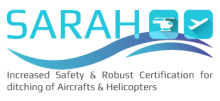SARAH
SARAH, a Horizon 2020 collaborative project, aims at establishing novel holistic, simulation-based approaches to the analysis of aircraft ditching. It is build up from a consortium of experts from OEM industries, experienced suppliers of simulation technologies, established research institutions and representatives of the certification authorities. Results of SARAH are expected to support a performance-based regulation and certification for next generation aircraft and helicopter and to enhance the safe air transport as well as to foster the trustworthiness of aviation services.
The Challenge
Aircrafts and helicopters often travel above water and thus have to prove a safe landing under emergency conditions. This is particularly true for fixed-wing aircrafts certification, but also for helicopters as they are strongly used to support marine tasks. The specific challenge, which affects the design of airborne vehicles, is to minimize the risk of injury to persons on board during the whole water landing and to enable safe evacuation of the occupants.
Accordingly, the motion of both the aircraft and the helicopter along with the forces acting on the structure are studied for controlled water impact during their design phase. Additionally, the subsequent floatation and the evacuation processes have to be considered. Ditching has close links with crash simulation, but also distinctive features. Examples refer to hydrodynamic slamming loads on airborne vehicles and complex hydromechanics (partially at very large forward speeds) as well as the interaction of multi-phase fluid dynamics (involving air, water, and vapor phases) and structure mechanics.
Design for ditching involves more than the analysis of loads and subsequent strengthening of the structure. It often requires adjustment campaigns for the handling of the vehicle during approach and the identification of favourable approach/flight-path conditions in line with the pilots flying capabilities to minimize the remaining kinetic energy of the vehicle to be transferred into the water.
The Objectives
…increase the safety of aircrafts and helicopters in ditching / floatation situations…
- improve aircraft/ helicopter certification tools in order to deliver accurate loads to safely design aircrafts/ helicopters and deliver input on how ditching needs to be simulated in order to obtain robust, safe and accurate loading information
- derive a robust way to safely design new configurations for which no engineering experience is available regarding ditching
- What kind of tools do we need?
- What kind of design is necessary?
- use methods obtained to analyse and optimise approach, landing and impact phases to supporting the pilot in water-landing scenarios
The SARAH project begun in October 2016 and will conclude its activities, having a lifespan of three years, in September 2019. The total budget of the project is approximately 6,6M€, funded by the European Commission under H2020-EU.3.4. - SOCIETAL CHALLENGES - Smart, Green And Integrated Transport (Grant Agreement number 724139).
For more information, visit the SARAH website (http://sarah-project.eu/).
Our projects
» HORIZON EUROPE
» CLEAN AVIATION
» H2020
- FUTPRINT50
- DOMMINIO
- TRAVISIONS2022
- SAFELAND
- IFACT
- UMA3
- OSCAR
- SLOWD
- ICARE
- RUMBLE
- NHYTE
- ICARUS (FETOPEN)
- RADIAN
- SARAH
- FUCAM
- EFFICOMP
- SUNJET II
- ComBoNDT
- PERSEUS
- TraMOOC (ICT)
» FP7
Contact
EASN Technology Innovation Services BVBA
Terweidenstraat 28
B-3440 Budingen
Belgium
EASN Technology Innovation Services BVBA
Patras Science Park
Stadiou Str., Platani
26504, Patras, Greece
Tel: +30.2610.911378
EASN Technology Innovation Services BVBA
Ioanni Polemi 32A
3085, Limassol , Cyprus
Tel: +357.25212390
EASN Association
© 2024 EASN Technology Innovation Services · All rights reserved


